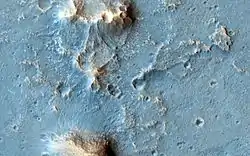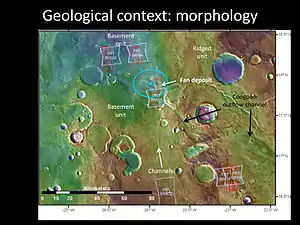 | |
| Location | Oxia Palus quadrangle |
|---|---|
| Coordinates | 18°16′30″N 335°22′05″E / 18.275°N 335.368°E |
Oxia Planum is a 200 km-wide clay-bearing plain located on the planet of Mars inside the Oxia Palus quadrangle on the eastern border of Chryse Planitia. The plain lies between the Mawrth Vallis outflow channel to the north-east and the Ares Vallis outflow channel to the south-west. In 2019, the International Astronomical Union Working Group for Planetary System Nomenclature officially approved Oxia Planum as a feature on the surface of Mars (near 18.275°N 335.368°E).[1][2]
Oxia Planum was one of eight potential landing sites for the European Space Agency and Roscosmos ExoMars mission. After a five-year-long selection process, it was officially selected to be the landing site for Rosalind Franklin (rover). It met the rover landing criteria based on its latitude, elevation,[3] surface slopes,[4] and its Noachian-aged terrains. It was chosen because of its relatively smooth topography and its abundance of hydrated minerals.[1][5][6]
Overview
Oxia Planum contains one of the largest exposures of clay-bearing rocks on Mars.[7] The age of the region was calculated to be from ~3.6 billion years old[8] to ~4 billion years old.[1][7] The site is iron-magnesium rich clays, indicating that water once played a role here. The site sits in an area of valley systems with the exposed rocks exhibiting different compositions, indicating a variety of deposition and wetting environments. Dark resistant units, named for being dark-toned erosion resistant areas, are spread across the surface of the site. The formation of the dark resistant units is hypothesized to have occurred from either fluvial deposits or by volcanic activity during the Amazonian period. The dark resistant units may have preserved the state of the older stratum beneath it.[1][9]
Clay accumulation underneath the remnants of a fan or delta near the outlet of Coogoon Vallis may offer preservation for biosignatures against the planet's harsh radiation and oxidation environment.[7][10][11]


Aeolian features
The aeolian features observed on Oxia Planum indicate a changing wind regime. The formation of periodic bedrock ridges (PBRs) is hypothesized to have occurred by exposure from erosion or by wind. The PBRs record the oldest wind period of the region and indicate a north-northeast or south-southeast wind direction. The formation of transverse aeolian ridges (TARs) occurred by wind. The TARs record a second wind period of the region and indicate a northwest or north-northwest to southeast or south-southeast wind direction. Dust devils and windstreaks from the modern wind period indicate a west-northwest to east-southeast and occasionally a north-northeast to south-southwest wind direction.[5][9]
See also
References
- 1 2 3 4 Quantin-Nataf, Cathy; Carter, John; Mandon, Lucia; Thollot, Patrick; Balme, Matthew; Volat, Matthieu; Pan, Lu; Loizeau, Damien; Millot, Cédric; Breton, Sylvain; Dehouck, Erwin (January 5, 2021). "Oxia Planum: The Landing Site for the ExoMars "Rosalind Franklin" Rover Mission: Geological Context and Prelanding Interpretation". Astrobiology. 21 (3): 345–366. doi:10.1089/ast.2019.2191. ISSN 1531-1074. PMC 7987365. PMID 33400892.
- ↑ "ESA mission updates". The Planetary Society. Retrieved May 1, 2021.
- ↑ Mandon, Lucia; Parkes Bowen, Adam; Quantin-Nataf, Cathy; Bridges, John C.; Carter, John; Pan, Lu; Beck, Pierre; Dehouck, Erwin; Volat, Matthieu; Thomas, Nicolas; Cremonese, Gabriele (March 1, 2021). "Morphological and Spectral Diversity of the Clay-Bearing Unit at the ExoMars Landing Site Oxia Planum". Astrobiology. 21 (4): 464–480. doi:10.1089/ast.2020.2292. ISSN 1531-1074. PMID 33646016.
- ↑ Turchinskaya, O. I.; Agapkin, I. A.; Dmitroskiy, A. A.; Slyuta, E. N. (March 2021). "Analysis of the Terrain and Surface Slopes of the Potential Landing Area of the ExoMars Spacecraft Oxia Planum". Lunar and Planetary Science Conference (2548): 2442. Bibcode:2021LPI....52.2442T.
- 1 2 Favaro, E. A.; Balme, M. R.; Davis, J. M.; Grindrod, P. M.; Fawdon, P.; Barrett, A. M.; Lewis, S. R. (2021). "The Aeolian Environment of the Landing Site for the ExoMars Rosalind Franklin Rover in Oxia Planum, Mars" (PDF). Journal of Geophysical Research: Planets. 126 (4): 2020JE006723. doi:10.1029/2020JE006723. ISSN 2169-9100.
- ↑ "Oxia Planum favoured for ExoMars surface mission". www.esa.int. Retrieved May 1, 2021.
- 1 2 3 Durnham, R. (October 21, 2015). "ExoMars 2018 rover heading for Oxia Planum". Red Planet Report. Retrieved October 22, 2015.
- ↑ Gary‐Bicas, C. E.; Rogers, A. D. (2021). "Geologic and Thermal Characterization of Oxia Planum Using Mars Odyssey THEMIS Data". Journal of Geophysical Research: Planets. 126 (2): e2020JE006678. doi:10.1029/2020JE006678. ISSN 2169-9100. S2CID 234174370.
- 1 2 Silvestro, S.; Pacifici, A.; Salese, F.; Vaz, D. A.; Neesemann, A.; Tirsch, D.; Popa, C. I.; Pajola, M.; Franzese, G.; Mongelluzzo, G.; Ruggeri, A. C. (2021). "Periodic Bedrock Ridges at the ExoMars 2022 Landing Site: Evidence for a Changing Wind Regime". Geophysical Research Letters. 48 (4): e2020GL091651. doi:10.1029/2020GL091651. ISSN 1944-8007. PMC 7988568. PMID 33776161.
- ↑ Thollot, P.; Quantin, C. (May 14, 2014). "Oxia Planum, landing site for Mars 2020" (PDF). Universite de Lyon, France. Retrieved October 22, 2015.
- ↑ Staff (October 1, 2014). "Possible Future Mars Landing Site in Oxia Planum - High Resolution Imaging Science Experiment". The University of Arizona. Retrieved October 21, 2015.
External links
- Google Mars zoomable map – centered on the Oxia area
- High resolution images of the Oxia Planum
.jpg.webp)